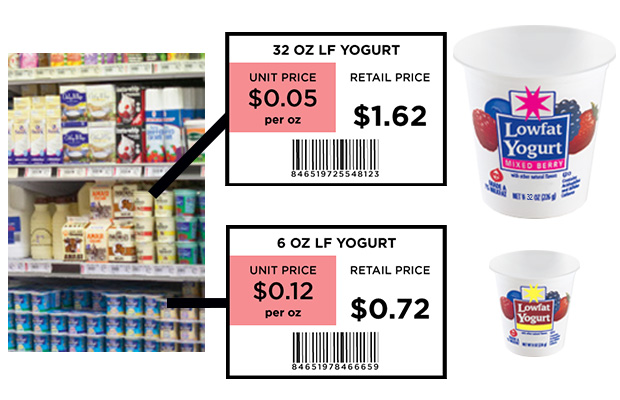
A Dozen Ways to Cut Down Your Next Grocery Bill
March 17, 2022
 By Michelle Hacker
By Michelle Hacker
Director of Digital ServicesIf you’ve noticed your grocery bill is a lot higher these days, you’re not alone. In fact, the US Department of Agriculture (USDA) is forecasting a 7% food inflation rate this year in its Food Price Outlook — the largest increase in 41 years.
At Security National Bank, our own investment team anticipates inflation to peak in the early 2022 months and remain elevated for some time after. So for the time being, it’s smart to adopt money saving habits for essential goods like groceries.
Here are some ways you can stay savvy while shopping for you and your family:
1) Be a digital “coupon-cutter.”
No longer must you scour the local newspaper, scissors in hand, slicing out stacks of paper coupons. Nowadays, “couponing” has moved to the Internet – where there are large databases of printable or scannable coupons for groceries and other household items (try Googling it for yourself).
If you’re shopping online, you can also download a money-saving widget — like Honey or Shopper.com — that’ll automatically scan the Internet for the best promo codes and apply them at checkout for you (the Honey App estimates a 17.9% average discount when you order online).
And hey, if you’re the nostalgic type, you can still always go the old-fashioned route with your scissors and local paper!
2) Join a loyalty program.
A lot of stores offer discounts to incentivize shoppers to keep coming back. So if you often shop at the same place, see if there’s a store loyalty program you might qualify to join, or a savings app you can download.
3) Buy frozen fruit and produce.
Believe it or not, frozen food isn’t any less healthy than fresh food (and in some cases, is actually healthier). Fruit and produce, in particular, are much more affordable when you buy them from the freezer — and they last longer!
4) Get dried beans instead of canned.
There’s a reason money guru Dave Ramsey pushes a “beans and rice” diet when guiding people out of debt: beans are cheap! And dried beans are even cheaper than canned ones, in addition to tasting fresher. If you’re following a recipe that uses canned beans, here’s a dried-to-cooked bean ratio to remember:
One cup of dried beans = about 3 cups of cooked beans.
5) Check the unit prices.
We often review the sticker price when we’re shopping and compare that between items, but it’s savvier to review the unit prices. This gives you a much clearer idea how much you’re getting for the price. The unit price is typically located in a smaller font below the price.

Source: Ohio State Extension Office
And it’s not true that the larger package always costs less per unit. Especially with paper products and condiments, a medium-sized package can often cost less than a bulk one. And when comparing, be sure your “unit measure” matches up (ounces, per hundred, per quart, per liter, etc.).
6) Freeze your meals. Love your leftovers.
Weekly meal prep is a popular and efficient grocery habit. Meal prep and freezing are budget-friendly, too, and can come in handy in a pinch. Rather than throw away the portions of food your family leaves on the table, put the food in freezer bags or containers and save them for a rainy day. You can also make more dishes than you need when you’re flush to offset cash-strapped times.
7) Avoid household items with your groceries.
Did you know items like light bulbs, batteries, furniture, cooking supplies, gift items and household cleaners have some of the highest markup percentages in grocery stores? That’s because you’re paying for the convenience to purchase them alongside your groceries. You can find many of these items for much lower prices at dollar stores, warehouse club stores or online.
8) Go generic.
Here's a crazy stat: On average, store brand or “off-brand” groceries cost 25% less than popular name brands. Despite what millions of dollars in marketing might be telling you, the quality of generic products is usually comparable. Go with the cheaper brand and save some money.
Keep in mind, you might have to search a little lower or higher on the shelf to find the generics, because name brands have bought the prime middle space. Looking a little harder will pay off in the long run!
9) Shop in bulk for shelf-stable items.
Find a good sale? Not every item is worth a bulk purchase, but it’s smart to stock up on shelf-stable items this way. Foods like white rice, honey, sugar, salt and corn starch are all widely used ingredients that you can have for a very long time. Other items that can remain on the shelf for a while: peanut butter, oatmeal, dried fruit, crackers and granola.
10) Skip the prepared foods aisle.
Obviously it’s less effort to grab the pre-made dinner off the shelf, but it also costs more and is often less healthy then finding the ingredients to make it yourself. If you’re shopping in season, fresh ingredients will taste better, too! Here's a link to the U.S. Department of Ag's in-season guide for the best fruit and produce to buy right now.
11) Use the store pickup option.
If your grocery store offers it, utilize the curbside or in-store pickup option. Shopping online help you see exactly what you’re purchasing, allowing you to edit your shopping cart easier and stick to your grocery budget. You’ll not only save time this way, but you’ll avoid the temptation of impulse purchases that can throw off your budget.
12) Download some cash-back apps.
Did you know there are more apps out there — like Ibotta, Rakuten, Checkout 51 and Fetch Rewards — that all offer cash-back incentives on certain goods? If it sounds like a scam, don't worry, it's not. Here's what BankRate says about why they work:
“Every time you use a cash back app to make a purchase, a retailer gets paid — and since retailers know the value of gaining new customers and maintaining loyal ones, they are more than happy to pay cash back sites in exchange for sending shoppers their way.”
Was this article helpful?
We want to provide solutions that matter, when you need them most. Subscribe to our newsletter and get great financial tips like this each month, handcrafted and delivered to your inbox.